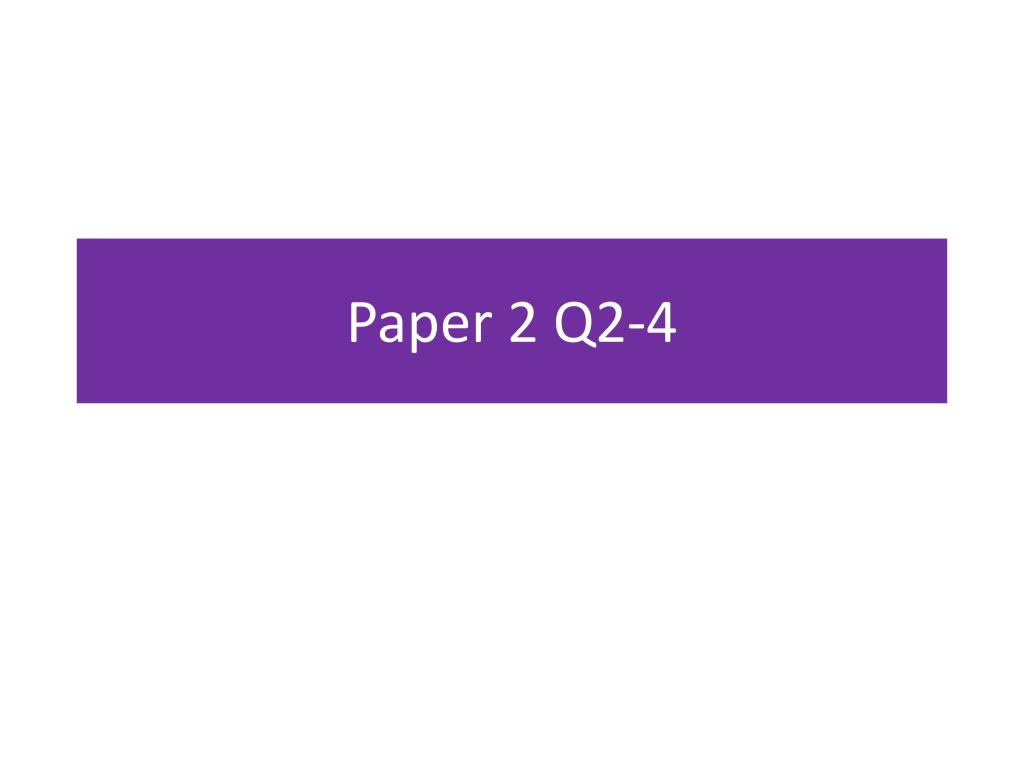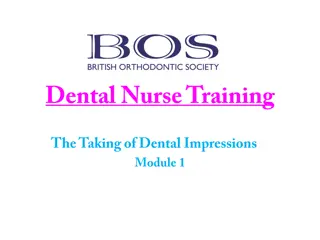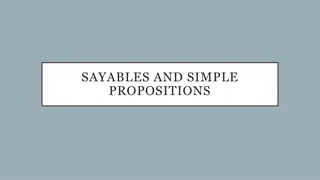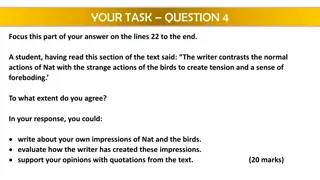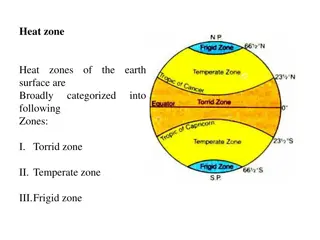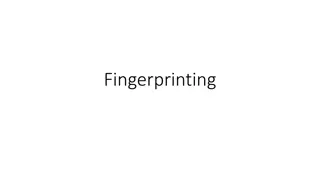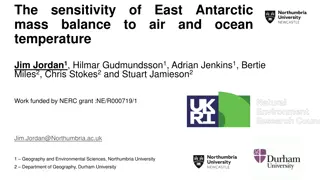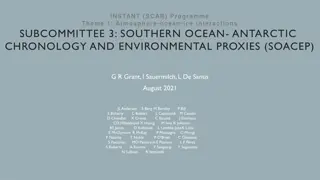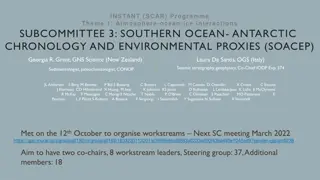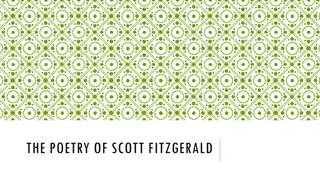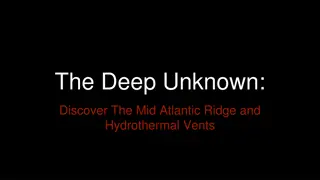Exploring the Antarctic: Scott's Journey and Impressions
Captain Robert Falcon Scott, a renowned Royal Navy officer and explorer, led expeditions to the Antarctic, setting records and exploring the great white desert. His diary entries capture the beauty, danger, and challenges faced by the explorers, highlighting the power of nature and the discomfort they experienced in extreme conditions.
Download Presentation

Please find below an Image/Link to download the presentation.
The content on the website is provided AS IS for your information and personal use only. It may not be sold, licensed, or shared on other websites without obtaining consent from the author. Download presentation by click this link. If you encounter any issues during the download, it is possible that the publisher has removed the file from their server.
E N D
Presentation Transcript
Scott of the Antarctic Captain Robert Falcon Scott, CVO, RN (6 June 1868 29 March 1912) was an English Royal Navy officer and explorer who led two expeditions to the Antarctic regions: the Discovery Expedition, 1901 04, and the ill-fated Terra Nova Expedition, 1910 13. On the first expedition, he set a new southern record by marching to latitude 82 S and discovered the Polar Plateau, on which the South Pole is located. During the second venture, Scott led a party of five which reached the South Pole on 17 January 1912, only to find that they had been preceded by Roald Amundsen's Norwegian expedition. On their return journey, Scott's party discovered plant fossils, proving Antarctica was once forested and joined to other continents.[1]A planned meeting with supporting dog teams from the base camp failed, and at a distance of 150 miles from their base camp and 11 miles from the next depot, Scott and his companions died from a combination of exhaustion, starvation and extreme cold. Wikipedia
Extract from Scott of the Antarctic https://www.youtube.com/watch?v=JkYIJ- 1LWgY
Scotts Diary February 2nd, 1911 Impressions The seductive folds of the sleeping-bag. The hiss of the primus and the fragrant steam of the cooker issuing from the tent ventilator. The small green tent and the great white road. The whine of a dog and the neigh of our steeds. The driving cloud of powdered snow. The crunch of footsteps which break the surface crust. The wind blown furrows. The blue arch beneath the smoky cloud. The crisp ring of the ponies hoofs and the swish of the following sledge. The droning conversation of the march as the driver encourages or chides his horse. The patter of dog pads. The gentle flutter of our canvas shelter. Its deep booming sound under the full force of a blizzard. The drift snow like finest flour penetrating every hole and corner flickering up beneath one s head covering, pricking sharply as a sand blast. The sun with blurred image peeping shyly through the wreathing drift giving pale shadowless light. The eternal silence of the great white desert. Cloudy columns of snow drift advancing from the south, pale yellow wraiths, heralding the coming storm, blotting out one by one the sharp-cut lines of the land.
Answer the questions for your chosen numbers. Answer in full sentences, using P.E.E where appropriate. Questions 1. How does the description in the Impressions section convey the scene for the reader? 2. Which details create a sense of the beauty of the scene? 3. Where is there a suggestion of the danger that the explorers face? 4. How does Scott use metaphors to create a sinister impression of the power of nature? 5. What makes the men uncomfortable in their tent? 6. Look again at the structure of sentences in the diary entry for 17th March, 1912. Why has Scott used some fragment sentences? 7. What impression does he convey of the character of Titus Oates? 8. Who do you think Scott had in mind as his intended audience for this piece of writing? What is his purpose in keeping the diary?
Exam Practice Q2: Both Scott and Simpson had to deal with difficult situations. Use details from both texts to write a summary of their different experiences. (12 minutes)
Q2 Mark Scheme Level 4 Perceptive, detailed 7-8 marks Shows a detailed understanding of differences Offers perceptive interpretation of both texts Synthesises evidence between texts Selects a range of judicious quotations from both texts Level 3 Clear, relevant 5-6 marks Shows a clear understanding of differences Begins to interpret both texts Demonstrates clear connections between texts Selects relevant quotations/references from both texts to support response Level 2 Some, attempts 3-4 marks Identifies some differences Attempts some inference from one/both texts Attempts to link evidence between texts Selects some quotations/references; not always supporting (from one/both texts) Level 1 Simple, limited 1-2 marks Shows simple awareness of difference(s) Offers paraphrase rather than inference Makes simple or no links between texts Simple reference or textual details from one/both texts
Create a table like this and add two more examples of difficult situations Source A ( Touching the Void ) Source B (Scott s diary) What s difficult and might be inferred from this? Difficult situations there was no possibility of getting back to that slope He went out into the blizzard and we have not seen him since. Both trapped. Could be frightened and suggests loss of hope. Inevitability Q2: Both Scott and Simpson had to deal with difficult situations. Use details from both texts to write a summary of their different experiences. (Remember to use quotations and to infer)
Before you answer Q2, here is a reminder of what you need to do The requirement to synthesise information into a summary means that students can either: write a single, integrated paragraph as a response to both sources write two connected (or linked) paragraphs as their preferred response to both sources. Note: Discourse markers and connectives work in both approaches and help students to write a more cohesive response. Sentence stems that signal inferential readings can help to ensure students meet a key requirement of this AO that is being assessed: This might suggest to me that You could infer from this that This makes me realise that
Now answer the question Q2: Both Scott and Simpson had to deal with difficult situations. Use details from both texts to write a summary of their different experiences. (12 minutes)
Peer assess WWW: A success in this work is EBI: You could work on ... THEN add a level and mark and sign it.
Q2 Mark Scheme Level 4 Perceptive, detailed 7-8 marks Shows a detailed understanding of differences Offers perceptive interpretation of both texts Synthesises evidence between texts Selects a range of judicious quotations from both texts Level 3 Clear, relevant 5-6 marks Shows a clear understanding of differences Begins to interpret both texts Demonstrates clear connections between texts Selects relevant quotations/references from both texts to support response Level 2 Some, attempts 3-4 marks Identifies some differences Attempts some inference from one/both texts Attempts to link evidence between texts Selects some quotations/references; not always supporting (from one/both texts) Level 1 Simple, limited 1-2 marks Shows simple awareness of difference(s) Offers paraphrase rather than inference Makes simple or no links between texts Simple reference or textual details from one/both texts
Q3... Q3: How does Scott use language to share his feelings in his diary? 20 mins
Language This question expects you to explore language use. What does this mean? Language= words! You need to analyse the words/phrases/language techniques the writer uses, and the effect of this language use. Effect means why the writer chose those words/phrases/techniques, and the effect they would have on the reader.
Q3 mark scheme Level 4 Perceptive, detailed 10-12 marks Shows detailed and perceptive understanding of language Analyses the effects of the writer s choices of language Selects a range of judicious quotations Uses a range of subject terminology appropriately Level 3 Clear, relevant 7-9 marks Shows clear understanding of language Clearly explains the effects of the writer s choices of language Selects relevant quotations Uses subject terminology accurately Level 2 Some, attempts 4-6 marks Shows some understanding of language Attempts to comment on the effect of language Selects some relevant quotations Uses some subject terminology, not always appropriately Level 1 Simple, limited 1-3 marks Shows simple awareness of language Offers simple comment on the effects of language Simple references or textual details Simple mention of subject terminology
Preparing to respond to Question 3 Q3: How does Scott use language to share his feelings in his diary? In pairs, skim read the text again and discuss what feelings Scott might have had. What examples/quotations can you select to support your points? 10 mins
Q3 ready, steady feedback Feelings: Feels it is both a dreadful and beautiful place goes from the ordinary, everyday items and contrasts them with power of nature Feeling of isolation, claustrophobia Sorrowful at Oates death admiring Helplessness
Explore the language use The patter of dog pads What can you say about the language used? (You need to be able to use terminology) Why did the writer choose this language/what is the effect on the reader?
Explore the language use The sun with blurred image peeping shyly through the wreathing drift What can you say about the language used? (You need to be able to use terminology) Why did the writer choose this language/what is the effect on the reader?
Explore the language use, and how it helps us to understand Scott s feelings Tragedy all along the line What can you say about the language used? Why did the writer choose this language/what is the effect on the reader? What does it tell us about his feelings?
Q3 your turn .. Now you have ideas for how to answer this question, it s your turn to have a go. Q3: How does Scott use language to share his feelings in his diary? 20 mins
Peer assess WWW: A success of this work is EBI: You could work on ... THEN add a level and mark using the next slide, and sign it.
Q3 mark scheme Level 4 Perceptive, detailed 10-12 marks Shows detailed and perceptive understanding of language Analyses the effects of the writer s choices of language Selects a range of judicious quotations Uses a range of subject terminology appropriately Level 3 Clear, relevant 7-9 marks Shows clear understanding of language Clearly explains the effects of the writer s choices of language Selects relevant quotations Uses subject terminology accurately Level 2 Some, attempts 4-6 marks Shows some understanding of language Attempts to comment on the effect of language Selects some relevant quotations Uses some subject terminology, not always appropriately Level 1 Simple, limited 1-3 marks Shows simple awareness of language Offers simple comment on the effects of language Simple references or textual details Simple mention of subject terminology
Q4 Compare the ways the writers ideas and perspective are conveyed in Touching the Void and Scott s Diary . (25 minutes)
Responding to Q4 Q4 assesses AO3, this explicitly requires students to compare how writers convey their perspectives: POV Paper 2 Q4, requires you to consider effects of languageas well as other methods ( eg tone of the writing, use of image to reinforce meaning, emphasis, bias ,what is present or omitted, narrative voice, tenses ).
Understanding the requirements I love Bognor Regis! It s a great holiday destination. I come to Butlins every year! From the text extract above, what are the writer s ideas? And what are the writer s perspectives? What methods have been used to convey the ideas and perspectives?
Understanding the requirements I love Bognor Regis! It s a great holiday destination. I come to Butlins every year! Ideas? writing about holidays, Perspectives? - expressing them very positively. Methods? - Opening exclamatory sentence I love Bognor Regis! uses the first person - gives direct personal opinion in a focus position and conveys enthusiastic tone. Repetition of this sentence type sustains and reinforces the tone. Adjectives love & great emphasise the enthusiasm & positivity. Adjective every denotes that the narrator feels this is the best and only choice.
Q4 mark scheme Level 4 Detailed, perceptive 13-16 marks Shows a detailed understanding of the differences between the ideas and perspectives Compares ideas and perspectives in a perceptive way Analyses how methods are used to convey ideas and perspectives Selects range of judicious quotations from both texts Level 3 Clear, relevant 9-12 marks Shows a clear understanding of differences between the ideas and perspectives Compares ideas and perspectives in a clear and relevant way Explains clearly how methods are used to convey ideas and perspectives Selects relevant quotations to support from both texts Level 2 Some, attempts 5-8 marks Identifies some differences between the ideas and perspectives Attempts to compare ideas and perspectives Some comment on how methods are used to convey ideas and perspectives Selects some quotations/references, not always supporting (from one or both texts) Level 1 Simple, limited 1-4 marks Simple awareness of different ideas and/or perspectives Simple cross reference of ideas and/or perspectives Simple identification of how differences are conveyed Simple references or textual details from one or both
Ideas and Perspectives Draw the following chart in your books Writer s perspective Methods Writer s ideas Text A Text B
Your turn for a full response Compare the ways the writers ideas and perspective are conveyed in Touching the Void and Scott s Diary Make sure you use COMPARATIVE CONNECTIVES, for example: whereas, differentiating from, unlike, similarly, both, alternatively, but, however. You have 20 minutes.
Self assessment Level 4 Detailed, perceptive 13-16 marks Shows a detailed understanding of the differences between the ideas and perspectives Compares ideas and perspectives in a perceptive way Analyses how methods are used to convey ideas and perspectives Selects range of judicious quotations from both texts Level 3 Clear, relevant 9-12 marks Shows a clear understanding of differences between the ideas and perspectives Compares ideas and perspectives in a clear and relevant way Explains clearly how methods are used to convey ideas and perspectives Selects relevant quotations to support from both texts Level 2 Some, attempts 5-8 marks Identifies some differences between the ideas and perspectives Attempts to compare ideas and perspectives Some comment on how methods are used to convey ideas and perspectives Selects some quotations/references, not always supporting (from one or both texts)
